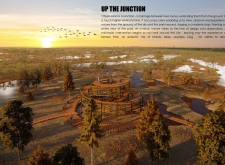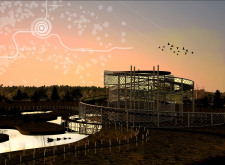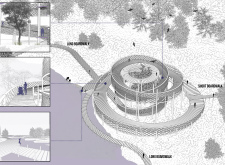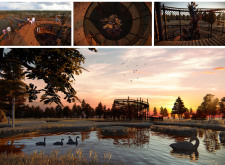5 key facts about this project
The architecture represents a modern interpretation of traditional design values, integrating contemporary materials with natural elements to create a welcoming environment. The use of glass facades fosters transparency, inviting daylight into the interiors while offering visual connections to the surrounding landscape. This choice of materials not only enhances the building’s energy efficiency but also establishes a dialogue with the adjacent structures and the context in which it resides.
Functionally, the project is designed to accommodate a mix of uses, including public and private spaces. The layout encourages interaction among users, with open-plan areas that facilitate social connectivity. Distinct zones within the project are carefully orchestrated to cater to varied needs, from collaborative working spaces to quiet contemplation areas, ensuring that the design organically supports the workflow and activities of its occupants.
Key architectural elements are thoughtfully implemented throughout the design. The incorporation of green terraces and landscaped roofs not only contributes to the aesthetic quality but also promotes biodiversity and mitigates urban heat. These features serve as recreational spaces for users while integrating nature into the urban fabric, enhancing the overall ecological footprint of the project. Additionally, large overhangs and strategically placed shading devices are incorporated to minimize solar gain and provide outdoor comfort, further showcasing a commitment to sustainable design.
The spatial arrangement within the project reflects a deep understanding of user dynamics. Circulation paths are clearly defined, allowing for intuitive navigation while ensuring that the functional zones remain easily accessible. The project's architectural designs exhibit a keen attention to detail, with custom fixtures and finishes that align with the overall design ethos. The interplay of textures, colors, and forms creates a rich sensory experience that resonates with users.
Unique design approaches are evident in the integration of technology and smart systems, which enhance the building's operational efficiency. This aspect is particularly relevant in today’s architectural practice, where the emphasis on technology-driven solutions is growing. The incorporation of smart lighting and climate control systems exemplifies a forward-thinking perspective, ensuring that the project not only meets the current needs but also anticipates future trends in sustainable architecture.
The architectural plans reflect meticulous consideration of both macro and micro elements, with comprehensive section drawings illustrating the relationship between different floors and spaces. Each layer of the design serves a specific purpose while contributing to the project’s overarching narrative. The architectural sections provide insight into the building's height and volume, emphasizing the relationship between interior spaces and external conditions, which is critical in urban settings.
As one explores this project, it becomes increasingly clear that the design prioritizes both functionality and user experience. By integrating community-oriented space with sustainable practices, it stands as a thoughtful response to the demands of modern living. The overall design outcomes resonate with both the users and the environment, establishing a balance that is essential in contemporary architectural discourse.
For a deeper understanding of the architectural ideas behind this project, interested readers are encouraged to delve into the architectural plans, architectural sections, and additional architectural designs available for exploration. Such an investigation will provide further insights into how this project effectively marries form and function within its urban context.


























